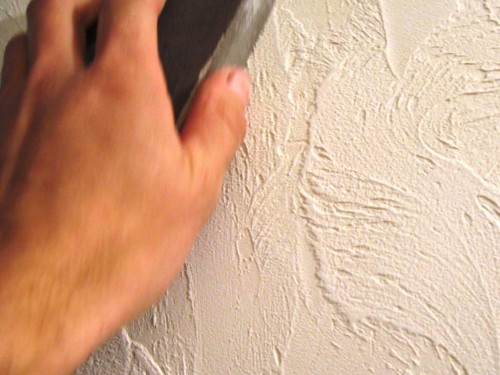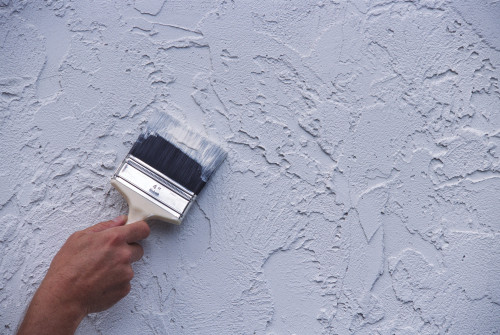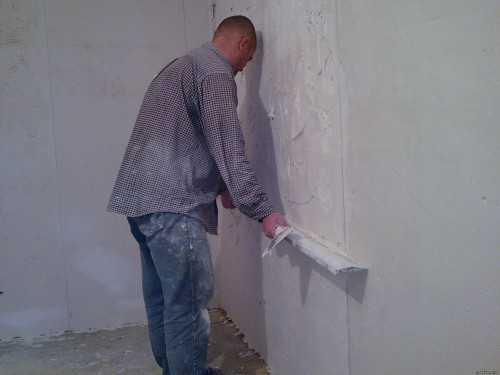To date, plaster walls is a common process in modern homes. Of course, many people still give preference to wallpaper, tiles, as well as other facing materials, but the plaster gradually displaces them from the construction and repair resources market.
Content
On the market now you can find a huge number of plaster, and much depends on how many owners agree to allocate money for the purchase of material. By the way, you can now find really expensive types of material that is not affordable even enough to people. However, there is a lot of lots in buying such products.
As for the process of plastering walls, there are often people without tremendous experience. Even newcomers are able to carry out a certain amount of work, without making anything like more. The main thing in this business is to establish the main difficulties that may arise in the process, and after that, start work. In addition, considerable depends on the existing space. For example, the room in which the plaster walls will be carried out can have too large area, and then the finishing process will be required to break into several stages. There can be a lot of similar details. The most important thing is to pay attention to all similar aspects and already be ready for them in advance.
In this article, we will consider in detail all the issues related to the choice and the process of applying plaster on the wall. In addition, focus on problems that will definitely take place in this process. With our recommendations, the finish process can hold people without the slightest experience.
Features and selection of plaster
If we are talking about the choice of decorative plaster, then it is necessary to keep in mind that there are a lot of similar products on the market. Accordingly, it is quite difficult to make a conscious choice.
It should be noted in advance that many builders believe that plasterboard is also plaster, but dry. In this article, we will consider it precisely classical plaster, which is applied to the walls with a spatula or tool similar to it.
To date, you can find a lot of plaster products on sale, but not all it is characterized by high quality. Unfortunately, there are many low-quality products on the market that someone definitely buys. In such a situation, it is most important to pay attention to the products from the famous companies that are already on the market for a long time ago. It is advisable to contact branded shops that have obviously high-quality plaster. The best option will appeal to a specialist. Often, many have familiar who are related to construction supermarkets. Accordingly, such people can roughly estimate the situation and give a good advice related to the choice of plaster. If there is no access to such information, you must always contact the largest building supermarket where they should not be deceived. Often in large trading networks provide only high-quality plaster, and also give a guarantee for some types of products.
Unfortunately, many owners are looking for places where you can buy a dry coating "with hands". In such cases, you can save a little, especially if there is a need for a large number of material. Unfortunately, in such situations you can easily get into poor-quality products, and the savings will come sideways.
Types of plaster
Often, it is possible to find 4 types of decorative plaster.
- Structural plaster. Often, such a finishing surface is called "Koroned". This is a kind of plaster, which has been greatly popular when finishing the external walls of shops, industrial buildings, as well as private houses. The graininess of the surface provides the wall of an attractive appearance. Moreover, externally, such a surface does not age, and for many years remains in one state. This is a significant advantage compared to the usual smooth plaster walls. It should be borne in mind that the size of the structural grain of plaster is often from 0.6 to 3 mm.
- Mineral plaster. To date, this type of plaster is actively used. The basis of this material is the crumb, which creates an otnaya appearance of space. Mineral plaster is used for finishing and external, and inland walls of houses. The main thing is to choose the appropriate material for the existing conditions (the plaster for the interior finish cannot be used for external walls, and vice versa). In addition, mineral plaster can be bright and dark. Often, various components are used that can give the surface of the shine. This type of plaster will be relevant for a long time.
- Texture plaster. This plastic material, which for various reasons is not used as often as other types of plaster. It is worth paying attention to the fact that it is due to the plasticity, the material applies if there is a need to create an original design in the dwelling. Plaster can be easily deformed and create entire drawings based on it. On the Internet you can find thousands of examples of creating the original surface style, however, it is necessary to have tremendous experience and the corresponding talent for the implementation of such ideas. Even to create a banal invoice (patterns, lines), it is necessary to have a skill and a certain experience, as it is easy to make a mistake, but it will not be possible to fix it quickly. Accordingly, it will be necessary to include in additional costs and specialists who will create a decor on the surface of plaster. It is worth noting that in the network you can find texture drawings simply with colossal scales, and it is obvious that such things are too expensive.
- "Venetian plaster. This material is universal, as it is possible to create imitation of valuable rocks of stones. In addition, on the basis of this plaster, without any problems, whole drawings are created, compositions that are able to turn a gray room in a truly cozy room. At the same time, work with this material is certain difficulties, since this plaster is applied to several layers, and then grout is used. Accordingly, the newbie in the repair business can handle this hardly.
Distinctive features of plaster:
- If the filler, which is in the mixture, is large, then there is a need for plastering only manually. Accordingly, this is a time-consuming process, which is not all forces.
- In the event that the plaster has a liquid base, it is not recommended to add water to it. The thing is that the plaster can lose its basic properties, and the high durability can be forgotten at all. In any case, all such questions are better to focus with the manufacturer or seller.
- Manually, when applying marble crumbs, problems may arise. First of all, the problem is that in the process of applying the structure of the material may be lost. Accordingly, without certain devices, it is better to do not start.
- Special attention should be paid to materials that have high adhesion rates. In some cases, due to loss of strength, the plaster may not be covered.
- In addition, if we are talking about the most non-toxic plaster, then these are materials that have a water base. At the same time, such plasters have a number of other flaws. In particular, we can talk about the consequences associated with the impact of the external environment.
Advantages and disadvantages of decorative plaster
Of course, when choosing between plaster and other finishing materials for walls, it is necessary to analyze all the strengths and weaknesses of resources. In this case, we will consider the advantages and disadvantages of decorative plaster.
Advantages:
- A large assortment. On sale you can detect a huge selection of plaster options. First of all, we are talking about color variations. Accordingly, there are no problems associated with the selection of the color of the finishing material for a particular space in the dwelling. Unfortunately, some other finishing materials cannot boast of such a variety.
- Attractive price tag. If we are talking about popular types of plaster, then it is often budget solutions for repair work in apartments. Accordingly, this material is somewhat more profitable for many other finishing resources. There are options that are cheaper than plastering, you need to remember.
- Reliability and durability. High-quality plaster, which is made by authoritative companies, will easily serve dozens of years. Moreover, the appearance of such a surface will always be attractive. This is an explicit advantage over plastic, some species of which, for example, can darken or yellowed over time.
- Easy repair process. Most common plasters apply very simple to the surface. Therefore, as we have said, even newcomer will cope with the case. It is worth noting the fact that today few of the owners are decided to conduct large-scale repairs with their own hands, but in the case of plaster there should be no problems.
Disadvantages:
- Low moisture resistance. Most types of plaster do not exist in the best way with high humidity. Accordingly, if you choose not the type of material for the bathroom, then gradually the plaster will be collapsed or lose its initial properties. In order not to get into a similar situation, it is necessary to study the documentation for the plaster.
- High laboriousness. Earlier we mentioned that the process of applying plaster is quite simple. At the same time, it is long, so alone spent plastered walls in a large room - extremely difficult. Compared with many other finishing materials, plaster is able to create the most problems.
- Absorbability of moisture. Unfortunately, most types of plaster actively absorb moisture. In such a situation, the material gradually collapses and loses its basic properties. Thus, you need to ensure that the moisture in the room where there is a layer of plaster has no effect on the state of the material. Plaster is the best suitable for the bedroom, hall, and sometimes for the kitchen. Most often, the documentation is supplied together with the plaster where such data is specified. It is necessary to adhere to all the limitations that are presented with information from the manufacturer.
The process of plastering walls
Surface preparation
Before proceeding directly to finishing work, it is necessary to prepare the surface, and also pay attention to all those details that may interfere with the finish.
- First of all, you need to remove all the wall materials. It may be wallpapers, plastic panels or other finishing resources. Most often, the walls can be found on the walls, as well as bulges from which you need to get rid of. In addition, on the walls, it is often possible to find cracks that need to be cleaned and get rid of garbage.
- If there are deep cracks on the surface, then it is advisable to fill them with parts of reinforcement or nails.
- Traces of mold or darkening should also be removed. For this use sandpaper.
- Immediately before the process of plaster, you need to think about improving adhesion. To do this, it is necessary to predict the surface. It should be paid to the fact that the primer is chosen depending on the type of plaster. It is best to clarify this issue with specialists, as it is extremely simple to make an error, and the overall quality of the surface may depend on it. Application of primer is an elementary process for which the roller will need from the tools.
Applying plaster
Now the time of the most responsible process has come - applying plaster on the walls.
- Most often, this process occurs in several stages (layers of material). The first layer is a spray that forms a 5-mm layer of plaster. The name indicates a method for applying plaster.
- After the first layer dries up, the second is applied, which completely covers the surface of the wall. This surface should be more thick, and the layer is the thicker of the previous one. It must be dissolved, and then - wait until it gets strength.
- The last layer of plaster is not so often used. It is called corrupt. The task of this layer is ideally for the surface, and its thickness should not exceed 2 mm. Often, this layer is applied only where there are minimal convexities or the deepening of the wall. If the wall is perfectly smooth, then there is simply no need for this layer.
It should be borne in mind that immediately apply the only pure layer - it is impossible, since the surface is most likely not to be different in durability and reliability. Several layers are a guarantee of high quality plaster works.
The application of the solution is performed using cells. The solution is visible to the sharp end of the instrument, after which it is brought to the wall. Stacking plaster is done using a conventional brush.
To spread the plaster on the wall, a falcon will be required to which the material is mounted, and then under the sharp angle are brought to the wall. The tool is underway, the perfect application of the solution on the surface is obtained.
Establishment of relief
To decorate the surface, the relief is often created, which is able to significantly decorate and transform the room. It is most important to pay attention to the fact that professionals are often engaged in such affairs who can combine styles and make some conclusions that relate to the overall dwelling design.
- To create a relief, use the appropriate tools. Often it is advisable to make a choice in favor of a rag or rubber roller on which there is a desired sample texture. Moreover, you can find curly spatulas, which are most likely the most simple and practical options for creating relief. Together with these tools, it is necessary to use a sponge or cloth to correct possible errors or folds when creating the relief.
- There are still many other tools with which you can create an original relief. It is not only about specialized tools, but also many other decorative devices. In stationery stores there are many embossed accessories, which can be used without any concerns in the repair process. In some cases, experts recommend using Christmas tree toys and similar items that can be applied to the surface and thereby create relief.
- If you need to get a clear relief, you should wait until the layer of plaster dry completely, and then apply another one - thin. Accordingly, by a thin layer, you can get a distinct pattern, which cannot be created in any other conditions.
- Often the hosts wish to create a relief on the surfaces of different shades. To do this, it will be necessary to create several layers of plaster - specifically to implement the original design style. Of course, all these layers should be thin, and the colors should not contrast too much. This process has many nuances, so experts are often invited to create decorative surfaces.
























